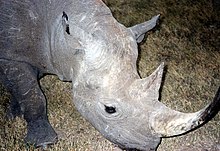Eastern black rhinoceros
| Eastern black rhinoceros | |
|---|---|

| |
| Scientific classification | |
| Kingdom: | |
| Phylum: | |
| Class: | |
| Order: | |
| Family: | |
| Genus: | |
| Species: | |
| Subspecies: | D. b. michaeli
|
| Trinomial name | |
| Diceros bicornis michaeli Zukowsky, 1965
| |
The eastern black rhinoceros (Diceros bicornis michaeli) is also known as the East African black rhinoceros. It is a subspecies of the black rhino. Its numbers are very low due to poaching for its horn and it is listed as critically endangered.
Description
The eastern black rhino is distinguishable from the southern subspecies as it has a longer, leaner, and more curved horn. Its skin is also very grooved. Diceros bicornis michaeli is also reportedly more aggressive than the other three subspecies of black rhino. They are browsers and are usually found in highland forest and savanna habitat.
Population and threats
Once located in Ethiopia, Somalia, Tanzania, and Kenya, as of 2010 they can only be found in Kenya (594 animals) and in northern Tanzania (80 animals). A population of currently 60 animals is kept outside its natural range in South Africa. The population has declined 90% in the last three generations. In 2010 their total numbers were estimated at 740 animals, with an increasing trend.[1] They are threatened mainly from illegal poaching for their horns.
The IUCN figures for Diceros bicornis michaeli also include those for black rhinos from South Sudan, Uganda, southwestern Ethiopia, and western Kenya. These are referred to a separate subspecies (Diceros bicornis ladoensis) by some authorities.[2] As the black rhino is extirpated in most of these areas, the status of the latter subspecies is unclear. Some animals of the Kenyan population may belong to it.
References
- ^ a b Template:IUCN2012.1
- ^ Hillman-Smith, A.K.K.; Groves, C.P. (1994). "Diceros bicornis" (PDF). Mammalian Species (455). American Society of Mammalogists: 1–8. doi:10.2307/3504292. JSTOR 3504292.
External links
- http://www.iucnredlist.org/search/details.php/39320/summ
- http://www.iucnredlist.org/search/details.php/39320/doc
- http://www.iucnredlist.org/search/details.php/39320/dist
- http://www.rhinos-irf.org/rhinoinformation/blackrhino/subspecies/eastern.htm
- http://www.rhinos-irf.org/ (International Rhino Fund dedicated to the conservation of rhinos)

